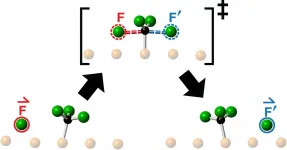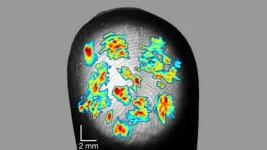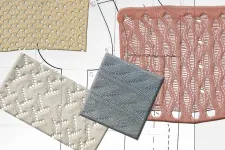(Press-News.org) TORONTO, ON - Research by a team of chemists at the University of Toronto, led by Nobel Prize-winning researcher John Polanyi, is shedding new light on the behaviour of molecules as they collide and exchange atoms during chemical reaction. The discovery casts doubt on a 90-year old theoretical model of the behavior of the "transition state", intermediate between reagents and products in chemical reactions, opening a new area of research.
The researchers studied collisions obtained by launching a fluorine atom at the centre of a fluoromethyl molecule - made up of one carbon atom and three fluorine atoms - and observed the resulting reaction using Scanning Tunneling Microscopy. What they saw following each collision was the ejection of a new fluorine atom moving collinearly along the continuation of the direction-of-approach of the incoming fluorine atom.
"Chemists toss molecules at other molecules all the time to see what happens or in hopes of making something new," says Polanyi, University Professor in the Department of Chemistry in the Faculty of Arts & Science at U of T and senior author of a study published this month in Communications Chemistry. "We found that aiming a reagent molecule at the centre of a target molecule, restricts the motion of the emerging product to a single line, as if the product had been directly 'knocked-on'. The surprising observation that the reaction product emerges in a straight line, moving in the same direction as the incoming reagent atom, suggests that the motions that lead to reaction resemble simple onward transfer of momentum.
"The conservation of linear momentum we observe here suggests a short-lived "transition state", rather than the previous view that there is sufficient time for randomization of motion. Newton would, I think, have been pleased that nature permits a simple knock-on event to describe something as complex as a chemical reaction," says Polanyi.
The team, which included senior research associate Lydie Leung, graduate student Matthew Timm and PhD graduate Kelvin Anggara, had previously established the means to control whether a molecule launched towards another either collides head-on with its target or misses by a chosen amount - a quantity known as the impact parameter. The higher the impact parameter, the greater the distance by which the incoming molecule misses the target molecule. For the new work, the researchers employed an impact parameter of zero to give head-on collision.
"We call this new type of one-dimensional chemical reaction 'knock-on', since we find that the product is knocked-on along the continuation of the direction of reagent approach," says Polanyi. "The motions resemble the knock-on of the steel balls of a Newton's cradle. The steel balls of the cradle don't pass through one another, but efficiently transfer momentum along a single line.
"Similarly, our knock-on reactions transfer energy along rows of molecules, thereby favouring a chain-reaction. This conservation of reaction energy in knock-on chemistry could be useful as the world moves toward energy conservation. For now, it serves as an example of chemical reaction at its simplest."
It has been known for well over a century that there is an energy barrier that chemical reagents must cross on their way to forming reaction products. An energized transition state exists briefly at the top of the barrier in a critical configuration - no transition state, no reaction.
Polanyi says the observation of collinear 'knock-on' provides insight into the reactive collision-complex, which lasts for approximately a million-millionth of a second. "Our results clearly tell us that the transition state at the top of the energy barrier lasts for so little time that it cannot fully scramble its momenta. Instead, it remembers the direction from which the attacking fluorine atom came."
In the 1930s, chemists began calculating the likelihood of forming a transition state on the assumption that it scrambles its energy, like a hot molecule. Although it was an assumption, it appeared well-established and gave rise to the statistical "transition state theory" of reaction rates. This is still the favored method for calculating reaction rates.
"Now, with the ability to observe the reagents and the products at the molecular level, one can see precisely how the reagents approach and subsequently how the products separate," Polanyi says. "But this runs contrary to the classic 90-year old statistical model. If the energy and momentum were randomized in the hot transition state, the products would not exhibit a clear memory of the direction of approach of the reagents. Energy-randomization would work to erase that memory."
The researchers say the observed directional motion of the reaction products favours a deterministic model of the transition state to replace the long-standing statistical model. Additionally, the observed reaction dynamics allow the reagent energy to be passed on in successive collinear collisions.
INFORMATION:
The research was funded in part by the Natural Sciences and Engineering Research Council of Canada (NSERC) and the University of Toronto NSERC General Research Fund. Theoretical calculations were performed on the Niagara cluster at SciNet HPC Consortium.
MEDIA CONTACTS:
John Polanyi
Department of Chemistry
University of Toronto
john.polanyi@utoronto.ca
Sean Bettam
Communications + Public Affairs, Faculty of Arts & Science
University of Toronto
s.bettam@utoronto.ca
Fingerprints may be more useful to us than helping us nab criminal suspects: they also improve our sense of touch. Sensory neurons in the finger can detect touch on the scale of a single fingerprint ridge, according to new research published in JNeurosci.
The hand contains tens of thousands of sensory neurons. Each neuron tunes in to a small surface area on the skin -- a receptive field -- and detects touch, vibration, pressure, and other tactile stimuli. The human hand possesses a refined sense of touch, but the exact sensitivity of a single sensory neuron has not been studied before.
To ...
Key Points
19.3% of children and adolescents in the United States have obesity and therefore have a higher likelihood of having obesity as adults and developing weight-related diseases.
This AJCN study assessed how strongly mothers' diets during pregnancy were associated with their children's growth rates during specific periods from birth through adolescence.
Study results suggest maternal nutrition during pregnancy may influence her offspring's weight gain during specific periods from birth to adolescence.
A pregnancy diet with higher inflammatory potential was associated with accelerated BMI growth trajectories in children, specifically those between three and ten years of age.
Rockville, ...
Recent summer droughts in Europe are far more severe than anything in the past 2,100 years, according to a new study.
An international team, led by the University of Cambridge, studied the chemical fingerprints in European oak trees to reconstruct summer climate over 2,110 years. They found that after a long-term drying trend, drought conditions since 2015 suddenly intensified, beyond anything in the past two thousand years.
This anomaly is likely the result of human-caused climate change and associated shifts in the jet stream. The results are reported in the journal Nature Geoscience.
Recent summer droughts and heatwaves in Europe have had devastating ecological and economic consequences, which will worsen as the global climate continues to warm.
"We're ...
In their study, which is now published in the journal Nature Aging, they show that the level of non-coding RNAs in the blood of a Parkinson's patient can be used to track the course of the disease. For their study, the team led by bioinformatics professor Andreas Keller and his doctoral student Fabian Kern created and analyzed the molecular profiles of more than 5,000 blood samples from over 1,600 Parkinson's patients. This resulted in around 320 billion data points, which the researchers analyzed for biomarkers of Parkinson's disease using artificial intelligence methods. ...
DURHAM, N.C. -- Researchers at Duke University have revealed long-hidden molecular dynamics that provide desirable properties for solar energy and heat energy applications to an exciting class of materials called halide perovskites.
A key contributor to how these materials create and transport electricity literally hinges on the way their atomic lattice twists and turns in a hinge-like fashion. The results will help materials scientists in their quest to tailor the chemical recipes of these materials for a wide range of applications in an environmentally friendly way.
The results appear online March 15 in the journal Nature Materials.
"There is a broad ...
An epigenetic modification that occurs in a major cell type in the brain's reward circuitry controls how stress early in life increases susceptibility to additional stress in adulthood, researchers at the Icahn School of Medicine at Mount Sinai have learned. In a study in Nature Neuroscience, the team also reported that a small-molecule inhibitor of the enzyme responsible for this modification, currently being developed as an anti-cancer drug, was able to reverse increased vulnerability to lifelong stress in animal models.
"It has long been known that stress exposures throughout life control lifelong susceptibility to subsequent stress. Here ...
Researchers have found that out of the more than 300 COVID-19 machine learning models described in scientific papers in 2020, none of them is suitable for detecting or diagnosing COVID-19 from standard medical imaging, due to biases, methodological flaws, lack of reproducibility, and 'Frankenstein datasets.'
The team of researchers, led by the University of Cambridge, carried out a systematic review of scientific manuscripts - published between 1 January and 3 October 2020 - describing machine learning models that claimed to be able to diagnose or prognosticate ...
In considering materials that could become the fabrics of the future, scientists have largely dismissed one widely available option: polyethylene.
The stuff of plastic wrap and grocery bags, polyethylene is thin and lightweight, and could keep you cooler than most textiles because it lets heat through rather than trapping it in. But polyethylene would also lock in water and sweat, as it's unable to draw away and evaporate moisture. This antiwicking property has been a major deterrent to polyethylene's adoption as a wearable textile.
Now, MIT engineers have spun polyethylene into fibers ...
The loss of glaciers worldwide enhances the breakdown of complex carbon molecules in rivers, potentially contributing further to climate change.
An international research team led by the University of Leeds has for the first time linked glacier-fed mountain rivers with higher rates of plant material decomposition, a major process in the global carbon cycle.
As mountain glaciers melt, water is channelled into rivers downstream. But with global warming accelerating the loss of glaciers, rivers have warmer water temperatures and are less prone to variable water flow and sediment movement. These conditions are then much more favourable for fungi to establish and ...
Ageing is a common factor in many diseases. So, what if it were possible to treat them by acting on the causes of ageing or, more specifically, by acting on the shortening of telomeres, the structures that protect chromosomes? This strategy is being pursued by the Telomeres and Telomerase Group of the Spanish National Cancer Research Centre (CNIO), which has already succeeded to cure pulmonary fibrosis and infarctions in mice by lengthening telomeres. Now they take a first step towards doing the same with renal fibrosis by demonstrating that short telomeres are at the origin of this disease, ...








